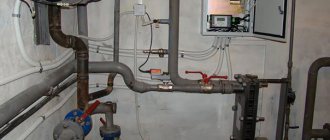How many approvals do you need to collect?
For individual heating, the apartment needs to be redesigned. Both the destruction of walls and partitions and their construction consist of a labor-intensive process. It will take a long time to receive each completed paper. It is necessary to take into account installation work and the purchase of materials, so reconstruction begins with the preparatory stages:
- determined with the collection of a documentary package;
- develop a project;
- purchase equipment;
- install an autonomous system.
The regulation for any redevelopment is the Housing Code of the Russian Federation, Article 26. The reconstruction of residential premises is carried out according to technical requirements; each stage of work must be agreed with the local government. To contact the regional authority, you need to collect documents that will serve as an appendix to the main application.
General documentary support for the submitted application, filled out according to the standard form:
- title documentation - this can be a certificate of ownership, transfer of an apartment by inheritance, a purchase and sale agreement;
- photocopy of technical passport;
- redevelopment of an apartment in the project;
- information about all registered persons in the residential area;
- written notarial consent of each registered person;
- confirmation that the building is not an architectural monument.
Redevelopment may be refused if it worsens the condition of the house or threatens the safety of residents. Project documentation for autonomous heating is coordinated with authorized organizations from the field of gas and heat supply.
To disconnect the heating circuit in an apartment from the general system, you need to obtain permission from the city or regional heating networks. Specialists of this level will agree to an agreement provided that the installations do not disrupt the functionality of the building's utilities and equipment. Only a security threat can lead to the refusal of a request for heating autonomy. Applications for an individual heating system are accepted by the housing management organization.
Actions consist of the following steps:
- receive a consent letter;
- contact the gas service;
- receive technical specifications;
- take apartment property documents;
- order a project;
- purchase equipment that meets the specifications.
SNiP41-01-2003 contains the basic requirements for heating and ventilation devices. You can be exempt from registration by concluding an agreement with an organization that provides such services.
Sample list of documents
Since installing your own heating system refers to the refurbishment of a residential premises, the list will include:
- an application drawn up in a special form;
- documents establishing the right to own housing: state registration certificate, deed of transfer of ownership, gift agreement, document confirming the right of inheritance (originals or copies certified by a notary);
- certified copies for each owner and a statement signed by all owners (if the apartment is in shared ownership);
- a copy of the technical passport of the premises;
- consent of family members of the tenant and residents of the apartment building, documented in the form of minutes of the meeting of apartment owners (if the area is municipal);
- conclusion of the body responsible for the protection of architectural monuments, historical or cultural heritage on the possibility of redevelopment (if the house is an architectural, cultural or historical value).
USEFUL INFORMATION: How to install a temperature controller on a battery
The most difficult thing will be to prepare and provide technical documentation. These include:
- redevelopment project for the installation of a gas boiler, including gasification of the premises and changes to the central heating system;
- a copy of the passport for the electric boiler, technical conditions, agreement confirming the permission of the maximum power, which exceeds the capabilities of the boiler (when choosing an electric heating device);
- Specifications for disconnecting the wiring in the apartment from the communal heating system;
- Specifications for ventilation;
- Specifications for supplying gas networks.
Obtaining a permit depending on the type of energy carrier
In 2012, Government Decree No. 307 was issued, which considered the legal procedure for connecting devices to supply heat to apartment buildings. The legal order establishes requirements for devices and prohibitions for installing equipment that does not meet technical conditions.
For example, gas boilers must meet the requirements:
- the combustion chamber is hermetically sealed;
- the fuel supply is automatically turned off;
- the carrier temperature does not exceed 90 degrees, with a pressure of up to 1 MPa.
When submitting an application for permission to disconnect from the general heating supply, indicate the type of boiler: single-circuit or double-circuit. Permits are obtained for both heating and hot water. The owner chooses a wall-mounted or floor-mounted boiler design.
The owner of the apartment will have to arrange a room that meets the following conditions:
- the room should not be residential;
- 4 sq.m. - square;
- 8 m – width of the entrance door;
- a window opening facing the street was cut through;
- equipped with a chimney;
- a ventilation structure has been installed.
Electric heating does not have such strict installation requirements. They install devices in any convenient place. This equipment does not require separate ventilation to remove combustion products, and power points are located in each room. The layout is approved by Energonadzor, the organization’s employees calculate additional sources, and allocate the power line of the required power.
Local heating networks and energy companies will provide their list of necessary documentation for connecting the boiler. Each district has established local requirements for equipment and installation. They are directly responsible to the executive branch and the law if an emergency occurs.
Electric heating can be using:
- units in which there is a normal pipe layout where the coolant circulates;
- direct heating devices, electrical systems, convectors, heaters.
When coolant is used, the piping to the radiators is not touched. They are connected to electric boilers, from which the coolant is heated instead of heating heating lines. Such units operate in an automatic heating system.
When heated, coolants from water or antifreeze pass through:
- boiler;
- heating circuit;
- radiators;
- cooling of the liquid;
- return and repetition of the cycle.
About the legal possibility of disconnecting from centralized heating services and installing autonomous (individual) heating in an apartment building in the following video:
April 11, 2021 Yulia Yurievna 36
Which boiler to choose: pros and cons of special equipment
Let's start, of course, with a gas boiler for an autonomous heating system. In general, there is at least one more option suitable for apartment buildings - an electric boiler.
But the most popular boilers today are gas ones. Moreover, they have proven themselves to be excellent not only in apartments, but also in private houses and cottages. And all because such equipment has the following advantages:
- Cheap fuel - gas, in comparison with other types of fuel, is relatively inexpensive, and therefore it can be used both for heating small city apartments and for heating spacious cottages.
- Almost complete absence of noise - if the gas boiler is noticeably noisy, it means that not everything is in order with the equipment.
- Compactness of gas equipment - for an apartment, a medium-power boiler is quite enough, which certainly won’t take up much space. As a rule, its dimensions are comparable to a section of a kitchen cabinet.
- Good functionality - modern gas equipment can be equipped with a variety of convenient devices for adjusting and monitoring operation.
But, despite such advantages, we cannot mention some obvious disadvantages. So, gas is a flammable substance, and therefore a gas boiler is a fire hazardous equipment. Therefore, in order to avoid not just problems, but a threat to life, only a qualified specialist with access to such work has the right to install it.
As a rule, modern equipment of this kind also includes a pump (except for one or two circuits), which creates the required level of pressure in the line. Systems in which the coolant moves by gravity are no longer used almost anywhere.
Some heating devices (but more often electric ones) also have an expansion tank. The latter is needed to compensate for the expansion of the liquid that occurs when heated.
We must not forget that fuel combustion products inevitably form in a gas boiler, which must be removed to the street. For these purposes, a special coaxial chimney is usually used. It goes without saying that a regular chimney is not provided in the apartment, and it is almost impossible to equip it.
Individual heating of an apartment: what is it, why and what for
Most often, people decide to abandon general heating due to the fact that:
- they are not satisfied with the quality of heating - lack of heat, discomfort in the cold season
- they want to regulate the level and timing of heat supply to the apartment themselves
- they want to reduce heating bills
In many new buildings, all apartments are initially equipped with an individual heating system, but residents of the old building should not be upset - it is quite possible to switch the apartment to individual heating. To do this, you will have to dismantle the old pipes and radiators, install new ones and connect them to the boiler-heater. The latter will heat the water and drive it through all the pipes, thereby heating the apartment. Hot water can also be connected to this boiler.
By installing his own heating system, the owner of the apartment will get rid of a lot of problems: he will no longer be afraid of planned and unscheduled shutdowns of heat and hot water supply, he will not freeze in severe cold and languish from the heat in the spring, when the sun is already blazing with might and main, but utility services are in no hurry turn off the heat supply. In general, there are a lot of advantages, but there are also quite a few problems. Before you acquire your own heating system, you will have to resolve a lot of issues, both technical and documentary. Let's deal with the technical side first.
Gas or electricity
When planning your own heating system, you need to choose what to heat with - gas or electricity. It is necessary to immediately make a reservation that we are talking about the system of the boiler itself, since the apartment is heated in any case by the liquid circulating through the pipes, but the boiler that heats it can run on both gas and electricity.
There is no doubt that gas boilers are the most popular. Their undeniable advantages are as follows:
- financial savings: gas is the cheapest type of fuel
- can be wall-mounted or floor-mounted - both are quite compact
- independence from electricity - in the event of a power outage, the apartment will not be left without heat and hot water
- greater efficiency - one boiler perfectly heats even the largest apartment
Conversion of apartment buildings to individual heating
Both the choice and installation of a gas boiler must be approached with all responsibility - after all, gas is not a joke, problems can lead to very sad consequences.
Therefore, it is best to contact specialists who will install all equipment correctly and safely.
There are apartment buildings that are completely devoid of gas supply.
In such apartments, only an electric boiler is possible, which also has its advantages:
- affordable price of the boiler itself
- high security
- ease of maintenance
- environmental friendliness, absence of any foreign odors and noises
But, of course, the cost of electricity when installing such a boiler will increase many times over. In addition, the apartment must have modern and powerful wiring that can withstand a sufficiently high voltage. In the event of a power outage, owners of such a heating system risk finding themselves without light and without heat.
Two circuits or one
Boilers are divided into single-circuit and double-circuit depending on the method of heating hot water. Single-circuit boilers are intended exclusively for heating an apartment; they will not provide hot water supply. True, you can connect an external boiler to them, which can heat water for the bathroom and kitchen.
A double-circuit boiler simultaneously heats the apartment and heats the water. This happens thanks to a special built-in heat exchanger - it is responsible for heating the water. Moreover, modern devices can have either one or two heat exchangers built in. In the first case, when cold water is heated, the heating supply is shut off. This is not very convenient, especially in winter. Two heat exchangers operate independently of each other, the water is heated without shutting off the heating, which allows you to constantly maintain the required air temperature in the room.
Disabling central heating
To transfer an apartment to autonomous heating, you must first submit an application to refuse to use centralized heating. When a positive decision is received, you can proceed to installing a boiler and other related equipment in the apartment.
To disconnect an apartment from central heating, you need to find out who is responsible for the pipes and radiators. If they are on the property of the home owners, then permission should be obtained from the neighbors. If the apartment building is served by special services, then you should submit an application with a request to be disconnected from the heating supply networks.
You must contact the home maintenance company and obtain permission. The document must record the approved scheme and include permission to transfer the apartment to individual heating. Only after this can you proceed directly to dismantling the old system and installing an individual heating scheme for the apartment. It takes quite a long time to switch from one to the other. The experience of many apartment owners suggests that this takes 3-6 months.
How to prepare a legal framework
Paperwork
So, the apartment owner has decided on the technical parameters of the equipment.
There remains one, but very significant question - obtaining permission to install this equipment in your apartment.
Only the interdepartmental commission responsible for the use of the housing stock can answer the question: is it possible to provide individual heating in an apartment in an apartment building?
This is where you will have to apply for the appropriate permission.
First of all, you need to prepare the following package of documents:
- application for installation of individual heating
- consent of all apartment owners
- protocol of a meeting of all residents of the house with consent to install individual heating in a specific apartment
- title documents for the apartment
- technical passport of the apartment and its copy
- if the house is an architectural monument, then the conclusion of the relevant authority on the legality and possibility of redevelopment
To collect all the necessary documents and permits, you will have to go around more than one service and organization. If you intend to install an electric boiler, then you must apply for permission to the city electrical networks. Permission to install a gas boiler is issued by the city gas service. Its specialists will inspect your home to ensure there is a working chimney.
Permission to disconnect from the communal heating system is given by the city heating network. The apartment renovation project will be approved by the design organization. In addition, this project must be coordinated with the SES authorities and the fire department.
When the entire package has been assembled, all necessary permits have been received and approved, you can safely purchase equipment and enter into an agreement with professional contractors who will quickly, correctly and safely install individual heating in your apartment. However, that's not all. The last step will be to receive the acceptance certificate.
Stages of installing autonomous heating
By analyzing the provisions of the regulations mentioned above, you can find the answer to the question of how to install individual heating in an apartment. To do this you need to go through the following stages:
- Submit an application for redevelopment to the management company.
- Receive a letter from the management company allowing you to disconnect the apartment from the network.
- Order technical specifications for individual heating. If the boiler is gas, contact the gas service. The received refusal can be appealed in court (does not apply to regions where there is no possibility of connecting to the gas system).
- Before installing individual heating in an apartment building, order a project based on the technical specifications.
- Obtain a fire safety report for the project from the Ministry of Emergency Situations.
- Coordinate all documents with urban planning and architecture authorities.
If, despite the presence of the listed documents, the applicant still receives a refusal, it will have to be appealed in court.
Alternative electric heating in the apartment
The easiest way to organize individual heating in an apartment with your own hands is to install electric boilers or film heating. To do this, you only need to complete the first stage - disconnecting from the central system.
Film heating in the apartment
First of all, you need to choose a method for heating the apartment. To do this, you can consider two options for individual heating in an apartment, made by yourself. The traditional one is to install water heating, where the function of heating the coolant will be performed by an electric boiler.
Such a system has a number of advantages - low inertia, the ability to install modern induction or electrode boilers. They do not require registration of individual heating supply in the apartment. The exception is models with a power of more than 9 kW. For their operation, a three-phase power supply of 380 V is required.
Installing IR film heating is important for apartments with a small area. It takes up little space and is also easy to install. The disadvantage of this system is its low inertia. First, objects that fall within the coverage area of the film heat supply are heated. But at the same time, the installation of individual heat supply PLEN in an apartment building can be carried out on the walls or ceiling of the rooms, which will practically not take up part of the living space.
It is recommended that certain conditions be met before installation begins. Unlike individual gas heating in an apartment, they are not mandatory, but experts advise adhering to them:
- Separate power cable from distribution block. This will stabilize the load on the electrical network in the house;
- Installation of RCD. In new buildings with individual electric heating, this device is installed by default;
- Installation of a two-tariff meter. If the heating supply operates during so-called preferential hours most of the time, this will reduce financial costs. This is not relevant for individual gas heating in an apartment building.
In addition to these methods, there is another way to maintain a comfortable temperature level in the premises. To do this, it is necessary to provide individual heating in an apartment building using electric convectors. But they are characterized by high energy consumption and, as a result, increased electricity costs.
Package of necessary documents
Functional indicators of centralized heat supply, constant accidents in heating networks, coolant of the same temperature regardless of street weather conditions, and all this, along with fairly high tariffs, pushes people to switch to individual systems. The consumer has every right to refuse government services if he has no debts to utility services. It is much easier for owners of private houses, since the transition to autonomous heating will not affect the neighbors in any way. In addition, you can develop a connection diagram already at the stage of building a house.
The first thing the apartment owner needs to do is to obtain approval from the gas and heating services to disconnect a specific apartment from the centralized supply of services. Next, a project is ordered from specialists with calculations and conclusions confirming that turning off the central heating in the apartment will not affect the operation of the entire system. Next, the following package of documents is submitted to the local administration:
- petition for redevelopment of the home;
- document confirming ownership of the apartment;
- registration certificate for the apartment;
- certificate of family composition;
- developed project;
- package of technical documentation for connecting an individual system.
A response with permission or refusal is provided no later than 1.5 months. If the issue is resolved positively, the applicant is issued a document authorizing him to carry out all the repair work described in the project.
In case of refusal, the administrative authorities are guided by the current rules and regulations. If the redevelopment disrupts the comfortable living of other residents of the house, permission to connect individual heating in the apartment is not issued.
What is autonomous heating?
The transition to individual heating of an apartment involves abandoning the use of a common building heating system and dismantling the radiators and pipes associated with it. Instead, new lines and batteries are installed, which are connected to the heater. Two types of installations are traditionally used in apartments - gas and electric boilers. The principle of operation of the device is simple: it increases the temperature of the water and forces it to circulate through the system, heating the room in the desired mode.
USEFUL INFORMATION: How to hide heating pipes in an apartment
Legislation 2021, is it possible to do without a lawyer?
Let us make a reservation that the creation of a completely autonomous, individual housing heating scheme in an apartment building has two sides to the issue: legal and technical. Oddly enough, the technical side of the issue is much easier to solve - modern manufacturers offer the widest selection of individual heating systems: from the simplest fan heaters to advanced complexes powered by renewable energy sources. But with the legal registration of leaving for “free heating swimming” you will have to tinker quite a bit.
Unauthorized transition from central heating supply threatens problems with the Criminal Code of the Russian Federation
We will consider the most drastic option - complete disconnection from the main heating systems. In fact, why pay at the same time for the heating services of the management company and spend money on maintaining your own individual heating system in the apartment.
If you do not consider yourself to have limited mental abilities, you can easily learn all the legal aspects in person, without spending money on the services of lawyers or law firms. To do this, just read the Law of the Russian Federation “On Housing and Communal Services”. He drew up a re-equipment project in a specialized organization, hired a team from a company licensed to carry out construction and installation work in the field of heat supply.
When refurbishing your apartment, you need to pay attention to ensure that the pipelines of the main heating systems do not release heat into your apartment. Our hero closed the circuit in the floor screed of his apartment, using metal-plastic pipes with minimal heat transfer
Thus, the lower floors were not left without main heat, and no one could blame him for being heated by these pipes.
After repair work, it is necessary to obtain documents confirming the commissioning of the apartment, which indicates the new heating characteristics. What such paper should look like is shown in the figure. After this, such paper is submitted to the management company and you will have to endure another round of battle with the employees of the management company, who clearly will not want their income to decrease due to the fact that you will no longer pay for heat.
Order on putting the apartment into operation after disconnecting from central heating
Gas boilers
Individual gas heating in an apartment building requires not only the preparation of all paperwork, but also a careful approach when choosing a boiler that will be entrusted with the heating task.
As a rule, consumers choose a double-circuit unit, which will provide apartment residents not only with heat, but also with hot water.
Today they produce small-sized wall-mounted devices with closed combustion chambers. This type of boiler simplifies installation tasks, since they do not require a gas duct, since this function is performed by a fan. It “pushes” air from the street, and then also removes combustion waste through special pipes.
The benefits of a two-chamber wall-mounted gas boiler are obvious:
- It combines both a heating system and a boiler for heating water.
- Saving fuel significantly reduces heating costs.
- Equipped with an electronic sensor and thermometers, such boilers can be adjusted and configured at your discretion.
If 10-15 years ago people wondered whether it was possible to install individual heating in an apartment, today many consumers are simply switching to alternative heating sources. If the apartment is not located in a harsh climate, it is recommended to connect electric heating in the apartment instead of gas.
Important information about an individual gas heating system
Among the advantages is the possibility of future savings on services. Also, the owners will have independence from planned and unscheduled outages of hot water and heating. Many people are attracted by the ability to maintain the desired indoor temperature throughout the year.
If a gas meter is not installed, and residents are forced to leave the apartment for some time, then they will not need to collect a number of documents certifying their actual absence and submit them to the competent authorities. It will be enough to simply turn off the gas boiler.
For heating an apartment in an apartment building, the market offers several options. Among them, the possibility of using natural gas for these purposes stands out. It allows you to reach the desired temperatures, which provides residents with a sufficient level of comfort
The owner of the apartment himself decides what temperature will be optimal for him. He himself calculates the budget for gas payments based on his needs and plans expenses.
Statistical calculations by experts on the installation of independent gas heating in apartment buildings show that when installing autonomous systems, on average, residents' heating costs are reduced by half, and water heating costs are reduced by three or more times.
Large boiler houses using main gas do not provide high efficiency due to significant heat losses on heating mains and other important factors.
An individual oversized system allows you to efficiently and quickly repair all key components, is characterized by low heat losses and, therefore, productive work and high efficiency.
Most new buildings are increasingly switching to individual gas heating. Such buildings are not initially equipped with risers. They immediately install boilers in each individual apartment
Safe operation of a gas boiler is ensured by proper installation of all systems, checking their functionality and the absence of gas leaks and exhausts. It is best to install a gas boiler in a separate boiler room to avoid exposure to accidentally leaked toxic gases that threaten humans.
Correct installation and installation of the chimney is a key point in installing a gas boiler. If carbon monoxide is not completely removed from the premises, then adverse consequences for the residents of the apartment are possible.
In order to install a gas boiler in an apartment, you must have a connected gas pipeline. If there is no gas pipeline yet, then it will take some time and a decent amount of money to build it. In addition, you need to obtain a number of permits. In such cases, everyone decides for themselves whether it is worth getting involved in this process and bringing it to completion.
When talking about individual gas heating in an apartment building, they do not always think about apartment-by-apartment installation of systems and boilers. Often, one powerful boiler is installed for an entire house or entrance, which provides heat to the entire system under its control.
Thanks to this option, residents are no longer dependent on the central highway. Typically, boilers are connected in basements.
Dependence on central heating dictates that residents need to pay the costs associated with heat losses. This is about thirty percent of the cost of heating services. Also, due to the fact that most city heating systems were built decades ago, they require regular maintenance.
An individual heating system can only be installed with a properly installed ventilation and smoke exhaust system. According to the standards, each operating boiler must be connected to a separate smoke duct. If there is no chimney, there is a high probability of receiving a refusal.
Maintenance is carried out by a number of specialists, the payment for whose work is borne by the residents of apartment buildings. By installing an individual system, residents thereby refuse to finance many unnecessary specialists. If a breakdown occurs in the installed system, you can always raise funds for repairs in an equal share from each resident.
For apartment heating, wall-mounted boilers are mainly purchased, and for heating the entire house, powerful models of floor-standing boilers are purchased. Installation of all equipment is carried out only by specialists authorized to carry out such work.
It is important to know that without permits you cannot independently carry out any work to set up autonomous heating. Independence in this case is destructive and can lead to long litigation and liability before the law.
If you still decide to implement your idea, then to implement it you need to go through a number of stages, which we will describe in this article.
Procedure for disconnecting from the centralized heating system
When preparing all the necessary documents for the transition to individual heating of housing, it is necessary to study the relevant legislation:
- Federal Law No. 190 of July 27, 2010;
- Decree of the Government of the Russian Federation No. 307 of April 16, 2012;
- Art. 25, 26 of the Housing Code of the Russian Federation.
The simplest solution would be to install an electric boiler. You just need to make an application and submit it to the district electrical network. If the technical conditions are appropriate, the permit will be issued quickly. But the heat generated in this case may exceed the cost of thermal energy from centralized heating.
Therefore, installing a gas boiler is more profitable in terms of cost savings, since the cost of natural gas is relatively low. But when carrying out individual gas heating, you will have to comply with many formalities:
You must obtain the appropriate technical specifications from the city gas service. Check the chimney for serviceability and obtain a conclusion about this from the All-Russian Voluntary Firefighting Society (VDPO). Obtain the consent of the remaining residents of the house (this point is specified in Part 3 of Article 36 of the Housing Code of the Russian Federation)
This is very important, because if one apartment refuses centralized heating, malfunctions in the operation of the entire system may occur. In addition, it is necessary to obtain relevant documents and find out who owns system elements such as batteries and piping
If they are in common property, it is also necessary to obtain special permission from the neighbors. If the heating components are not common property, permission to disconnect must be obtained from the management company. In city heating networks, obtain the right to dismantle the heating system in your apartment.
For those residents who have gas water heaters installed in their apartments, it will be easier to obtain permission for individual heating, since such buildings have a chimney, and the pressure in the gas pipeline is suitable for the operation of a gas boiler.
Having received preliminary permission for a gas heating project, you should prepare the following documents:
- A statement in which you must indicate that the owner of the apartment plans to make individual heating and disconnect from the centralized system.
- The original registration certificate of the apartment, which should indicate the location of the batteries and pipes.
- Permission from the residents of the house (if the system components are common property) or from the management company.
- Decision on possible redevelopment of the apartment. It is issued by the housing office or management company.
The period for obtaining permission to dismantle the centralized system and install an individual one can last from 3 months to six months. Once permission has been received from representatives of the utility service, you can proceed to dismantling the heating elements in the apartment.
Documentation of an autonomous heating system
In order to obtain permission for individual heating in an apartment, you need to collect the documents listed in Art. 26 of the Housing Code of the Russian Federation:
- An application indicating the address of the apartment in which the redevelopment will be carried out, the signatures of all interested parties, the planned scope of work and other parameters.
- Title documents for housing: sales and purchase agreements, rental agreements, certificate of ownership.
- Residential renovation project.
- Technical passport of the premises.
- Consent of family members, where they will indicate whether it is possible to install autonomous heating in the apartment.
- Conclusion of the authority for the protection of architectural monuments on the admissibility of redevelopment if the house is a protected cultural object.
You need to submit documents to the local administration or the MFC.
Often these authorities refuse to register redevelopment, citing the project’s non-compliance with the law or incomplete information in the documents. However, you need to understand that the reason for the refusal is that:
- None of the officials will take responsibility for authorizing the redevelopment, because mistakes made can lead to the disrepair of the apartment building.
- It is extremely unprofitable for utility authorities to allow the transition to autonomous heating, since this will lead to a reduction in payments.
In this case, you will have to defend your rights in court.
In what cases is the consent of neighbors not required?
It also happens that the issue can be resolved without a general house meeting. This happens when the heating system in the house and all its elements are not designated by documentation as common property. But even this fact does not mean that independent shutdown will be natural.
In this case, it is necessary to obtain permission from a local organization that provides resource supply services, since during the reconstruction the house registration certificate will need to be edited.
Its third section, in particular, lists detailed information about the heating system. The law regards any change and installation as a technical change that must be included in the technical passport.
The procedure goes better if all residents of the house want to connect individual heating.
Then, at a general vote in the apartment building, an appropriate decision is made, signatures are collected on the consent of all owners and technical documentation is prepared.
Is it possible to do the installation yourself?
In order not to hire specialists, but to do the installation yourself, you need to know how individual heating works. But even after studying all the nuances, such actions as installing the boiler and auxiliary equipment, connecting gas and laying risers should be carried out by specialists from the relevant services. But everyone can install radiators. The main thing is to check the tightness before using the system. Leaks are usually detected at the junctions of radiator sections or pipes and radiators. A reliable way to check for leaks is to let coolant into the system. You must be prepared to immediately fix the leak so as not to flood your neighbors.
Heating scheme
In centralized heat supply, a single-pipe scheme is used, which is inferior in efficiency to a two-pipe scheme. The single-pipe system is used only for a small number of radiators in situations where savings are needed.
The optimal choice for individual heating is a two-pipe scheme. It has the following advantages:
- use of pipes and fittings of smaller diameter;
- high pressure stability in the system;
- the possibility of installing automatic flow regulators on all batteries, which will operate without compromising the heating of other radiators;
- independent connection of each heating section, allowing it to be removed for maintenance or gaining access to the niche during repairs.
USEFUL INFORMATION: Installing water meters: how to seal and verify water meters
Installation process
Installation work to install the heating system is carried out in accordance with technological requirements and is carried out in several stages. Failure to comply with clear rules and requirements can cause incorrect operation of the equipment and lead to an emergency.
Marking
First of all, markings are applied in places where pipes will pass and radiators will be installed.
In order for the elements of the highway to be at the same level, as required by the technology, marks are placed using a level.
Radiator installation
At the next stage, the batteries are attached to their seats. To do this, holes for fasteners are drilled at the marked points with a hammer drill, which need to be secured with dowels.
Radiators are hung on the installed fasteners, and fittings are screwed to them.
Pipe laying
Then they begin to pull the pipes. Their assembly begins from the beginning of the wiring and, accordingly, the return. Using a soldering iron, fittings are welded to the edges of the pipes that will connect the line to the heating boiler. The soldering process consists of stripping the edges of the pipes from foil and inserting them into the nozzle of a heated soldering iron; in parallel, the fitting is heated in the same way to the desired temperature (usually 260 °C).
Next, the parts are joined with hot edges in a straight line and pressed tightly - this forms a homogeneous permanent connection. Similarly, the edges of the contour parts are connected along the entire perimeter of the apartment. To avoid deformation of the pipes, they are fixed to the wall with fasteners every 65–70 cm.
At the junction of radiators with plastic elements of the heating system, corner valves are welded. The system is ready for connection to a gas boiler, the installation and connection of which is best left to qualified specialists due to the complexity of the work and increased safety measures for its implementation.
Individual heating in an apartment: dream or reality
Many people do not even suspect that it is possible to install individual heating not only in a private house, but also in an apartment. However, for some apartment owners the heating issue is so acute that they are seriously considering this possibility. What makes residents of an apartment building think about connecting an autonomous heating system? There are many reasons for this:
- unreasonably high cost of utility bills;
- poor-quality heating, which does not allow maintaining a comfortable temperature in the apartment during the cold season without the use of additional heat sources;
- unfavorable location of the apartment, requiring more intensive heating - corner apartment, first floor;
- dependence on the established dates for the beginning and end of the heating season, causing you to freeze in the fall and suffer from the heat in the apartment in the spring;
- the desire to maintain optimal temperature at any time, paying money only for actual heat consumption.
Advantages and disadvantages of independent heating
To understand whether it makes sense to abandon the central heating supply in favor of an autonomous one, it is worth weighing all the pros and cons of a separate option.
Advantages:
- Significant savings. According to reviews from owners who have switched to autonomous gas heating, the cost of heating an apartment is reduced by 6–7 times.
- Complete independence from the start and end of the heating season.
- The ability to adjust the temperature at your discretion. Some systems allow you to set the desired mode, in which the heating intensity changes at specified intervals. For example, when all family members are at work or school, the temperature drops by several degrees, and in the evening it rises again. This allows you to further increase your savings.
- Uninterrupted supply of hot water.
- Free choice of radiators. Any batteries are suitable for an individual system, since there is no possibility of water hammer.
Flaws:
- High cost of equipment.
- Dependence of modern boiler models on power supply.
- The need to install a new heating circuit.
- In many cases, there is a need to install a suitable exhaust duct.
You can learn more about the advantages and disadvantages of autonomous heating in an apartment in a multi-storey building from the owners’ words by watching the video.
Ban on individual heating in an apartment building
To carry out the reconstruction of a residential premises, the owner of this premises or a person authorized by him directly submits to the approval body at the location of the residential premises being converted: 1) an application for reconstruction in the form approved by the federal executive body authorized by the Government of the Russian Federation; 2) title documents for the residential premises being rebuilt (originals or notarized copies); 3) a project for the reconstruction of the residential premises being rebuilt, prepared and executed in accordance with the established procedure; 4) technical passport of the residential premises being rebuilt; Thus, you need to contact the local government body (district administration) with an application for reconstruction of the apartment, attaching the above documents.
However, it should be borne in mind that in accordance with Art.







